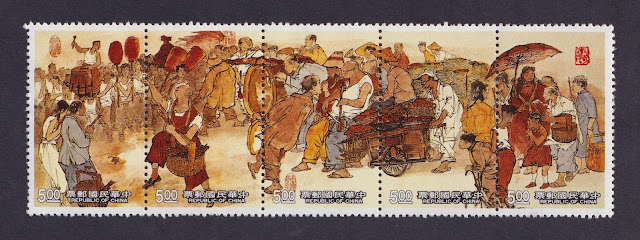Technical Details:
Issue Date: 22 September 1992
Dimension of stamps(mm.) 30x49
Printer: China Engraving & Printing Works, R.O.C.
Designer: Li Chi-mao
Sheet Composition: 10×5
Process: Deep etch offset
Paper: Locally-made mat finished, watermarked stamp paper with gum
Perforation: 11 1/2
Many of the beliefs of our people are a combination of religion and ancient myths. The adoration of spirit and soul and to remember the endeavors of our ancestors through the activities of the temple fair have positive influences on daily life. Through the devoutness of religious duties, our people are able to readjust body and spirit. This set of stamps depicts the pure and simple characteristics of our religious culture through the prosperity of a temple fair of the countryside. It consists of five 5.00 stamps which are arranged in a se-tenant strip.
Dimension of stamps(mm.) 30x49
Printer: China Engraving & Printing Works, R.O.C.
Designer: Li Chi-mao
Sheet Composition: 10×5
Process: Deep etch offset
Paper: Locally-made mat finished, watermarked stamp paper with gum
Perforation: 11 1/2
Many of the beliefs of our people are a combination of religion and ancient myths. The adoration of spirit and soul and to remember the endeavors of our ancestors through the activities of the temple fair have positive influences on daily life. Through the devoutness of religious duties, our people are able to readjust body and spirit. This set of stamps depicts the pure and simple characteristics of our religious culture through the prosperity of a temple fair of the countryside. It consists of five 5.00 stamps which are arranged in a se-tenant strip.








